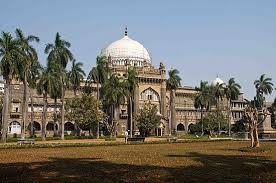Places to visit in Aurangabad
Known as the ‘City of Gates’ Aurangabad is one of the popular places to visit in India. The large industrial city in West- Indian in the state of Maharashtra, serves as the Gateway to the World Heritage sites of the Ajanta and Ellora caves. Also, the city in itself, has a very rich heritage, since for a part of Aurangzeb's rule, Aurangabad was the seat of the Mughal dynasty. In fact, the town gets its name from the Mughal Emperor, Aurangzeb.
The charm of a holiday in Aurangabad comes from its historic sites, colourful culture and the thrilling experience. The Daulatabad Fort is one of the architectural wonders of the Mughal dynasty while sharing roots with its Mughal legacy, interestingly Bibi-ka-Maqbara is known as ‘Taj Mahal of the Deccan’. The Aurangabad Caves are interesting specimens of the old days, dating back to the 5-6th centuries, while a little overshadowed by the popular UNESCO world heritage sites of Ajanta and the Ellora Caves. Museums and weaving centres also hold appeal to the visitors.
Besides the tourist attractions of Aurangabad, it is definitely impossible to not pay a visit to the world-famous Ajanta and the Ellora Caves. The rock-cut Ajanta Caves lies about 107 km away. Shaped in the form of a gigantic horseshoe, the 30 caves lie snuggled amid the panoramic gorge. Undoubtedly, Ajanta finds mention among the finest examples of some of the earliest Buddhist architecture, cave paintings and sculptures. Dating back to the 2nd century BCE to 480 CE, these caves comprise Chaitya Halls, or shrines dedicated to Lord Buddha and Viharas or monasteries used by Buddhist monks for meditation and the study of Buddhist teachings. Adorning the walls and ceilings of the caves are paintings that illustrate incidents from the life of Buddha and various Buddhist divinities.
The next most popular tourist attraction are the Ellora Caves, 26 km north of Aurangabad. The site of cave temples and monasteries date back between the 5th and the 11th century A.D. Carved over a period of about 600 years, there are 34 caves. Ellora is one of the largest rock-cut monastery-temple cave complexes in the world. The heritage site contains Buddhist Chaityas or halls of worship and Viharas or monasteries, in addition of Hindu and Jain temples. In the 2km excavation site dug from high basalt cliff is Dhumar Lena (cave 29), the earliest excavation while the most imposing is the magnificent Kailasa Temple (cave 16)- world’s largest monolithic structure.

Bibi Ka Maqbara
"Taj Mahal Of The Deccan" - The Bibi ka Maqbara is a beautiful mausoleum of Rabia- Ul - Daurani alias Dilras Banu Begum, the wife of Mughal Emperor Aurangzeb. Bibi ka Maqbara was constructed by Aurangzeb in the year 1661 in the memory of his wife. Aurangzeb attributed this magnificent edifice in the name of his son Azam Shah who was born in the year 1653, so as to commemorate Rabia - Ul - Daurani, who left for her heavenly abode in the year 1657.

Chhatrapati Shivaji Maharaj Museum
Chhatrapati Shivaji Maharaj Museum - Established in the honour of the great Maratha ruler, Shivaji Maharaj, the Chhatrapati Shivaji Museum, located near Nehru Bal Udyan, has a marvellous collection of artefacts belonging to Maratha Empire. The main highlight of the museum is the 500-year-old armour, an equally old traditional Paithani Saree and a copy of the Holy Quran that was written by Aurangzeb. Housing 6 exhibition halls, the Chhatrapati Shivaji Museum in Aurangabad is a rich source of knowledge of the Maratha valour.

Aurangabad Caves (Ajanta and Ellora)
Ajanta and Ellora caves, considered to be one of the finest examples of ancient rock-cut caves are located near Aurangabad in the state of Maharashtra, India. Adorned with beautiful sculptures, paintings and frescoes, Ajanta and Ellora caves are an amalgamation of Buddhist, Jain and Hindu monuments as the complex includes both Buddhist monasteries as well as Hindu and Jain temples. The Ajanta caves are 29 in number and were built in the period between 2nd century BC and 6th century AD whereas the Ellora Caves are more spread out and 34 in number and dates to the period between 6th and 11th Century AD

Panchakki historical place
Panchakki, known as the water mill. This monument is located in Aurangabad, Maharashtra, displays the scientific thought process put in medieval Indian architecture. It was designed to generate energy via water brought down from a spring on a mountain. The building, attached to the dargah of Baba Shah Musafir a Sufi saint is located in a garden near the Mahmud Darvaza and consist of a mosque, a madrassa, a kacheri, a minister's house, a sarai and houses for zananas






